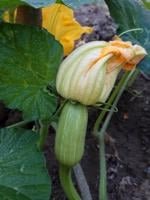Successful squash plant pollination could require you to work
By Connie Mehmel
WSU Chelan/Douglas County Master Gardener


Squash plants, a staple of home vegetable gardens, put forth many large, lovely flowers in early summer. But most of these flowers will never develop fruits because, for all their beauty, the flowers are botanically imperfect.
Perfect flowers have both male and female parts. The male parts (anthers) produce pollen and the pistil (female part) receives pollen that fertilizes the ovule so fruit can develop. Tomatoes, peppers and eggplants have perfect flowers, so every flower can fertilize itself and produce a fruit.
The imperfect flowers of squash plants are either male or female. A male flower produces pollen, which must be transported to a female flower for fertilization.
Home gardeners often wonder why so many flowers on their squash plants die without producing fruit. While there may be a problem with lack of pollination or abortion due to excess heat, most likely the dying flowers are males that have already done their duty.
Most squashes produce about 50% male flowers. Frequently they produce more males early in the season, frustrating impatient gardeners. Bees must do the work of pollinating squashes.
Honeybees often visit squash blossoms, but native squash bees (Peponapis and Xenoglossa) are more efficient. They start early in the morning, before honeybees are active, and may get the job done before honeybees arrive. Before honeybees were introduced to the Americas, squash bees were the primary pollinators of squashes.
A close look will tell you if a flower is male or female. If the base of the flower is a straight stem, then it is male. Female flowers are usually larger than males and have a swollen base with a bulb that looks like it could develop into a squash fruit.
If you look inside the flowers, you will see other differences. Inside the male flowers are several stamens that hold pollen. By contrast, inside the female flower is a large central structure, which is the pistil.
To be sure that squash flowers are pollinated, avoid using insecticides during the flowering period.
Squashes are in the genus Cucurbita, which includes summer and winter squash, pumpkins, zucchini and gourds. All of the species in this genus can cross pollinate, so if you plan to save your squash seeds for planting in the future, it is a good idea to hand pollinate your female flowers. Otherwise, the busy bees may cross your zucchini with a pumpkin, or your butternut squash with a gourd.
You can use a small brush to move pollen from a male flower stamen to the tip of a female flower pistil, then cover the female flower with a fine mesh bag until the fruit has set. Squash blossoms are edible, so you can fry your early-season male flowers with chili and cheese if you don’t need them for pollination.
